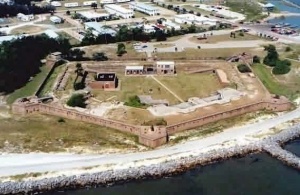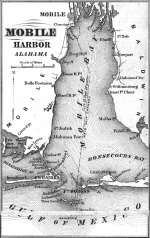Fort Gaines (1): Difference between revisions
John Stanton (talk | contribs) No edit summary |
John Stanton (talk | contribs) No edit summary |
||
| Line 55: | Line 55: | ||
<gallery> | <gallery> | ||
Image:Fort Gaines.jpg|View of Parade grounds taken at Fort Gaines Al 5 Sep 2009 | Image:Fort Gaines.jpg|View of Parade grounds taken at Fort Gaines Al 5 Sep 2009 | ||
Image:Fort Gaines SW(w).jpg|View of parade grounds in Fort Gaines Alabama from the southwest side of Battery Staton | |||
Image:Fort Gaines SE (w).jpg|View of the parade grounds at Fort Gaines Alabama from the southeast side of Battery Staton) | |||
Image:Fort Gaines Ext (w).jpg|View of the Exterior of Fort Gaines Alabama from the northwest) | |||
</gallery> | </gallery> | ||
Revision as of 07:14, 23 September 2009
Fort Gaines (1) (1821-1946) - Construction on this Third System masonry fort began in 1821 but construction and funding problems prevented completion and a redesigned fort was started in the 1850's. Designed by Joseph G. Totten and named after Gen. Edmund P. Gaines in 1853. The fort was still incomplete in 1861 when the U.S. Civil War began. The fort was occupied by Confederate forces in 1861 and they finished the fort in 1862. Abandoned after World War I and reactivated during World War II it was abandoned after the end of World War II.


Fort Gaines (1) History
Established to defend the narrow entrance to Mobile Bay, Alabama along with Fort Morgan.
Fort Gaines was designed as a regular pentagon with bastions at each corner and ten guns mounted on each of the five walls. Each bastion was to have four flank howitzers. A thirty-five foot wide dry moat surrounded the twenty-two foot high walls with a drawbridge for access.
U.S. Civil War

At the beginning of the U.S. Civil War in 1861 the Alabama State Militia seized both Fort Gaines and Fort Morgan from Federal troops. Fort Gaines remained in Confederate hands until 8 Aug 1864 when it was surrendered after the Battle of Mobile Bay to a Union fleet commanded by Adm. David Farragut. The Battle of Mobile Bay was the occasion for Adm. Farragut's famous order, "Damn the torpedoes, full speed ahead!", referring to torpedoes strung across the channel into Mobile Bay.
Endicott Period
In March of 1898 the fort was reactivated and garrisoned in anticipation of the Spanish American War and as a result of the explosion that sunk the Battleship Maine in Havana Harbor 15 Feb 1898. Construction began on the first Endicott Period battery in 1898. Three Endicott Period batteries were built between 1898 and 1901. The Spanish American War was quickly over but the strengthening of coastal defenses continued.
| Battery Click on Battery links below |
No. | Caliber | Type Mount | Service Years | Battery Cost | Notes |
|---|---|---|---|---|---|---|
| Battery Unnamed | 2 | 8" | Rodman | 1898-1899 | $ ? | Covered by Battery Stanton |
| Battery Stanton | 3 | 6" | Disappearing | 1899-1900-1901-1932 | $ 67,250 | 1 gun removed 1917 |
| Battery Terrett | 3 | 3" | Masked Parapet | 1900-1901-1901-1917 | $ 6,965 | |
| Source: CDSG | ||||||
World War I
A Coastal Artillery unit manned the disappearing guns during World War I. An anti-aircraft gunnery school operated from Fort Gains during and following the war.
World War II
The fort was used by the Alabama National Guard and the U.S. Coast Guard during World War II.
Current Status
The United States sold Fort Gaines to the City of Mobile in 1926. The city in turn gave the property to the Alabama Department of Conservation, which deeded it to the Dauphin Island Park and Beach Board.
|
{"selectable":false,"width":"500"} |
Location: Eastern tip of Dauphin Island, Alabama Maps & Images Lat: 30.248465 Long: -88.075569 |
Sources:
- Weaver, John R. II, A Legacy in Brick and Stone: America Coastal Defense Forts of the Third System, Redoubt Press, McLean, 2001, First Printing, ISBN 1-57510-069-X, page 175-177
- Roberts, Robert B., Encyclopedia of Historic Forts: The Military, Pioneer, and Trading Posts of the United States, Macmillan, New York, 1988, 10th printing, ISBN 0-02-926880-X, page 5
Links:
Visited: No
Fort Gaines (1) Picture Gallery
|
Click on the picture to see a larger version. Contribute additional pictures - the more the better! |
-
View of Parade grounds taken at Fort Gaines Al 5 Sep 2009
-
View of parade grounds in Fort Gaines Alabama from the southwest side of Battery Staton
-
View of the parade grounds at Fort Gaines Alabama from the southeast side of Battery Staton)
-
View of the Exterior of Fort Gaines Alabama from the northwest)
